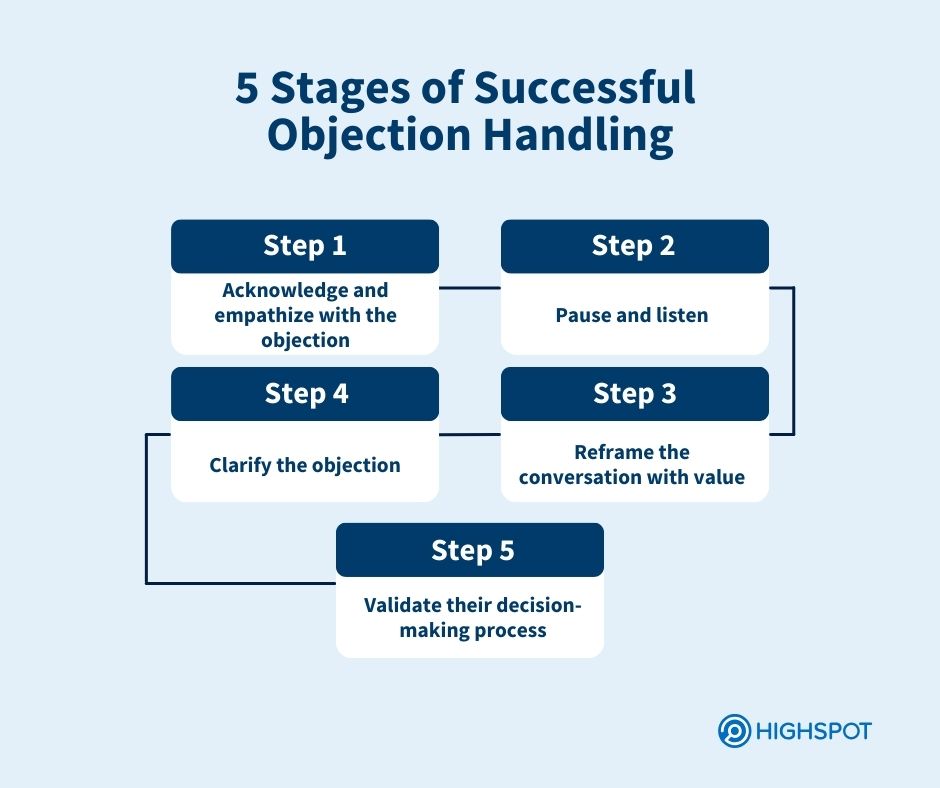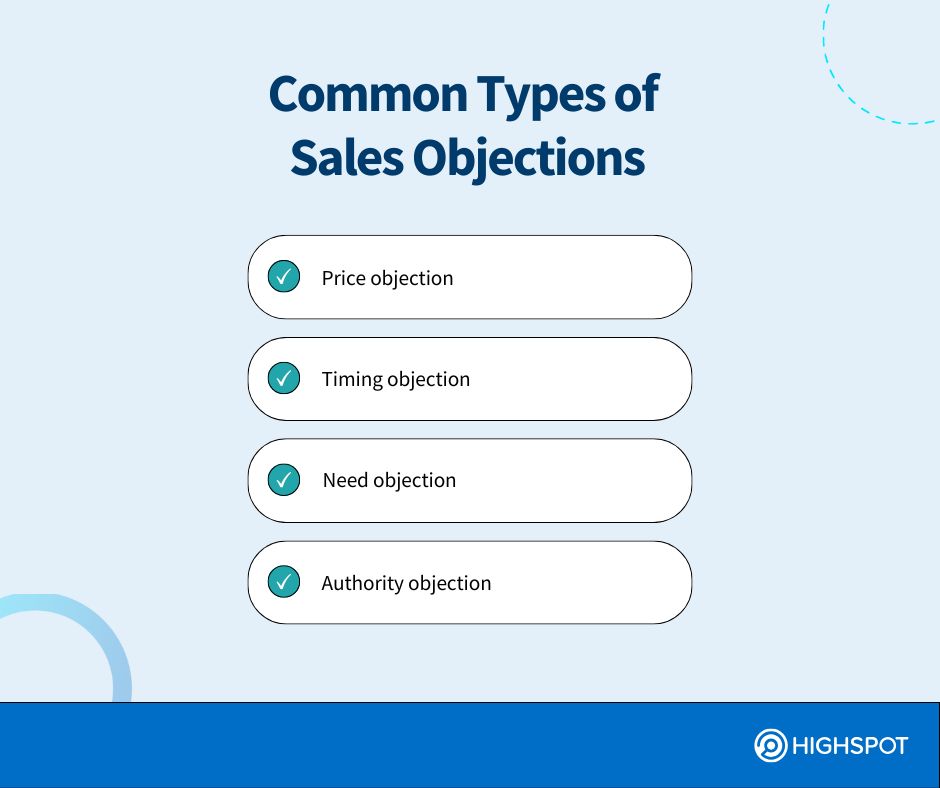Key Takeaways
- Reps who anticipate sales objections and approach them strategically build stronger relationships and close more deals.
- Active listening skills are essential for overcoming objections.
- Remain prepared because 60% of customers say “no” four times before finally accepting a sales offer.
Sarah, a seasoned sales rep, was close to sealing the deal. The prospect seemed interested, nodding along as she explained the value of her solution. Then, it happened—”This is too expensive.” Her stomach dropped. She had rehearsed her sales pitch a hundred times and put so much time into pursuing this prospective buyer. This felt like a dead end.
Sound familiar? If you’ve worked in sales for some time, you’ve heard customer objections like this more times than you can count. But, objections aren’t dealbreakers. They’re buying signals. In fact, 60% of customers say “no” four times before finally accepting a sales offer. This means giving up after the first “no” is a missed opportunity. The key to successful outcomes is your response and navigation.
This guide will help you master the objection handling process, break down common objections with practical approaches, and assess your skills with a confidence scorecard so you can turn hesitant prospects into loyal customers.
What is Objection Handling?
Objection handling is responding to and resolving a prospect’s objections during the sales process. Instead of avoiding objections in sales calls and seeing them as barriers, skilled reps use them as an opportunity to guide the customer journey, show value, and build trust.
Why Objection Handling Matters
Effective objection handling is fundamental to a successful sales effort. Rather than letting potential objections shut down the conversation, top sales teams use them to dive deeper into a prospect’s concerns. An objection often reveals other pain points they hadn’t fully considered.
By practising active listening, observing body language, and encouraging ongoing dialogue, sales reps can address what’s driving the hesitation. Overcoming most sales objections with confidence builds credibility and increases conversions.
The 5 Stages of Successful Objection Handling
When a prospect raises concern, it’s tempting to immediately defend your product, list its benefits, or convince them they’re wrong. But that approach rarely works.
Instead, think of objections as a chance to move the sale forward. It’s a natural part of the sales negotiation process. Every hesitation and “not right now” tells you more about what’s holding them back. Once you understand that, you can guide them forward. This is your chance to let them elaborate so you can understand and address their concerns collaboratively rather than confrontationally.
Here are five stages for handling objections to keep the conversation flowing in a positive direction. As you go through each step, apply essential sales skills to help guide the prospect toward the decision, rather than feeling like you’re pushing them into a corner.

1. Acknowledge and Empathise with the Objection
Make the prospect feel heard before you respond. This doesn’t mean you agree with the specific objection; it simply shows you understand their perspective.
For example, if a prospect says, “This seems too expensive,” don’t immediately justify the price. Instead, respond with something like, “I completely understand that budget is a big factor in your decision. Many of our customers had the same concern at first.”
This simple acknowledgement lowers their guard and keeps them talking. They might even offer further objections. You can also strengthen this by relating their worry to your other customers’ experiences. For example, “I’ve worked with other companies in your industry that were very concerned about budget and long-term costs, and I’d love to share how they navigated that decision.”
Using empathy and validation builds trust and keeps the door open for more conversation.
2. Pause and Listen
Sales reps often feel pressure to respond immediately, but objection handling in sales is just as much about active listening as it is about speaking. The first thing a prospect says isn’t always the real objection. If you jump in too quickly, you risk missing additional context and responding to the wrong pain point.
For example, if the prospect says, “We don’t have the budget,” pause for a moment. They might follow up with, “It’s not just the upfront cost; it’s also the expense of integrations, training, and implementation that we will incur switching from our current vendor.”
Now you know their concern is about switching costs, not just price. That’s a broader challenge, and you can respond in a way that covers all the appropriate details.
If they don’t elaborate, you may prompt them with an open-ended question: “Can you tell me more about that?” This will hopefully uncover the real issue and keep the exchange from feeling transactional.
3. Clarify the Objection
Once you’ve listened, confirm your understanding before responding. Many objections are surface-level expressions of more significant concerns, and if you misinterpret them, you risk giving the wrong response.
A great technique is paraphrasing: “It sounds like your main worry is how this will integrate with your existing system. Is that correct?” This prevents misunderstandings because sometimes what people say and mean are different. The prospect will also notice that you are paying attention to the granular details and taking the time to understand them before pushing a solution.
Once you’ve clarified the objection, ask more open-ended questions to uncover additional details.
- “What would make you feel more comfortable about implementation?”
- “If budget were a non-issue, what else would be important to you?”
By keeping the conversation open, you get to the root of the objection and position yourself as a problem-solver, not just a salesperson.
4. Reframe the Conversation with Value
Now that you understand their concern, it’s time to shift the focus away from the objection and toward your product or service’s value proposition.
If price is the issue, reframe the conversation around return on investment with, “I completely understand budget constraints, and that’s exactly why our clients choose us. We help them save [X dollars/time] within [specific timeframe], ultimately making this an investment that pays for itself.”
If they’re hesitant about switching, focus on what they stand to gain, such as “Many companies in your industry are initially hesitant to switch, but after seeing how much time they save with automation, they realise they were losing more by staying with their old system.”
Instead of arguing against their objection, show them how moving forward benefits them and their business.
5. Validate Their Decision-Making Process
Finally, make them feel in control of the conversation and their ultimate decision. Prospects don’t like feeling pressured; when they do, they often withdraw. Instead, acknowledge that this is a big decision and ask what would make them more confident moving forward. For example, “I understand this is a big decision for your team. What is the next step in your internal buying process?”
If they need approval from decision-makers, don’t just end with, “Let me know what they say.” Instead, offer to help them present to the team or provide supporting resources. For example, “Would it be helpful if I provided a business case or ROI analysis for your leadership team?”
By validating their process and offering assistance, you remove any roadblocks or hesitancy they might have and make it easier for them to move forward on their terms.
One effective way to master these steps is to leverage your sales playbooks. They provide structured guidelines that keep reps aligned and consistent. You can include scripted responses, tips for building rapport, and proven strategies for addressing objections, which helps sales reps confidently approach every conversation.
The Most Common Sales Objections and How to Handle Them
Every sales objection falls into one of four categories: price, timing, need, or authority. Recognising each type of sales objection when it arises makes it easier to respond strategically and continue the conversation.
Now, let’s apply the five-stage framework to the most common sales objections:

Price Objection
- “It’s too expensive.”
- “We don’t have the budget right now.”
- “This is too much for us to handle financially.”
How to handle it:
- Acknowledge and empathise: “I completely understand since the budget is an important factor for any business decision.”
- Pause and listen: Ask an open-ended question if encouragement is needed.
- Clarify the concern: Discuss their expectations. “Can you share what budget range you had in mind?” or “Is the concern about total cost or uncertainty about ROI?”
- Reframe with value: Explain how the investment pays for itself: “Many of our customers initially felt the same way, but they found that by automating [specific process], they saved [X hours/dollars] within [specific timeframe].”
- Validate decision-making process: “Would an ROI breakdown help in discussing this with your buying group?”
If budget is a real issue, offer some flexibility. Look into breaking the cost into phases or a pay-as-you-go subscription. Do you have a lower-tier option? Help them see a path forward instead of a dead end.
Timing Objection
- “We’re not ready to make a decision right now.”
- “We have too much going on right now.”
- “This seems overwhelming to implement.”
How to handle it:
- Acknowledge and empathise: Discuss how timing is everything, and given business stress, it may never be the right time. “I understand that timing is important, and making a change can feel overwhelming.”
- Pause and listen: Ask an open-ended question if encouragement is needed.
- Clarify the concern: “What’s your ideal timeline?” “Are there specific milestones you need to hit first?” “Is this about conflicting internal priorities or implementation time?”
- Reframe with value: “We can roll this out in phases to make it more manageable. Would it help to start small and expand functionality later as you need it?”
- Validate the decision-making process: “What’s the best way for us to stay aligned and move forward when the time is right?”
You can always offer to reduce risk with a pilot programme. A small test run gives the prospect a low-pressure way to see the value firsthand.
Need Objection
- “I don’t think we need this right now.”
- “We’re happy with our current solution.”
- “Our current process works fine.”
How to handle it:
- Acknowledge and empathise: “That makes sense, I understand that you might not feel like you need this right now.”
- Pause and listen: A lack of perceived need often means the prospect does not recognise the problem your solution solves. You may need to ask a discovery question, such as, “Can you walk me through your current process? Are there any challenges?”
- Clarify the concern: Determine whether their existing solution truly solves business pain points or if they are unaware of inefficiencies. “Are there areas where you wish your current solution did something different?”
- Reframe with value: Highlight a gap they might not have considered. “Companies in your space saved 20% in operating costs after implementing our solution. Would it be worth exploring?”
- Validate their decision-making process: Make it easy for them to take the next step. “Would it help if I showed you how other similar companies made the transition?” Now may be a good time to share customer references.
If they’re using a competitor, differentiate your solution. Ask them, “What’s one thing you wish your current vendor did better?” If your product fills that gap, you’ve just created a compelling reason to switch without directly attacking the competition.
Authority Objection
- “I need to check with my boss.”
- “I’m not the decision-maker.”
- “I need more information to convince my leadership team.”
How to handle it:
- Acknowledge and empathise: “I completely understand, and that makes sense, getting buy-in is important.”
- Pause and listen: If they don’t share anything else, you may ask for details by saying, “Who else needs to be involved in the decision?”
- Clarify the concern: Find out if they have a challenge presenting the business case or need to gather more details. “Is the challenge explaining the value to your leadership team, or do they need more information?”
- Reframe with value: Offer to help them with this presentation by asking, “Would it be helpful if I provided a business case template, ROI analysis, or social proof, like a success story for you to share? I’m also happy to join a call with your leadership team?”
- Validate their decision-making process: “What’s the best way to align with your team’s decision-making timeline?”
It’s often best to schedule a call with the chief revenue officer or key buying stakeholders (with the prospect’s approval) to ensure information isn’t relayed secondhand. This allows you to address concerns directly and maintain momentum.
Practise Objection Handling with Ongoing Training and Coaching
Objection handling improves with real-world practice and feedback. The best way to gauge progress is to monitor how conversations progress during the sales process.
Newer sales reps may find objections more challenging since responding requires strong product knowledge, competitive intel, and an understanding of customer demographics and needs. However, even experienced sales professionals can benefit from refining their objection handling techniques by participating in role-playing scenarios, assessing discovery calls to identify improvement areas, and participating in training and coaching sessions with sales leaders to fine-tune their next sales call.
Sales training platforms like Highspot can help you accelerate this learning process. These tools provide interactive simulations, data-driven feedback, and analytics that help sales teams sharpen their techniques.
Many also integrate AI sales coaching, which offers call recording analysis and automated skills assessments to help sales reps identify patterns and learn from top performers. This ensures that every interaction becomes a learning opportunity, leading to more confident reps, stronger customer relationships, and higher close rates.
Objection Handling Scorecard
Use this scorecard to gauge your confidence and skill level in handling objections. Rate yourself on a scale of 1 to 5.
- 1 = Needs Improvement
- 3 = Average
- 5 = Strong Skill
| 1 | 2 | 3 | 4 | 5 | |
|---|---|---|---|---|---|
| I acknowledge objections without becoming defensive. | |||||
| I pause and listen before responding to objections. | |||||
| I ask open-ended questions to understand the genuine concern. | |||||
| I tailor my response based on the prospect’s specific concerns. | |||||
| I reframe objections by highlighting value instead of arguing. | |||||
| I validate the prospect’s decision-making process before closing the conversation. | |||||
| I confidently handle price objections by shifting focus to value and ROI. | |||||
| I help prospects navigate internal approvals with proof instead of waiting for them to follow up. |
Following your assessment, identify areas for improvement that will benefit from sales training and coaching.
Better Equip Your Sales Reps with Highspot
While it would be ideal for prospects to be agreeable throughout the entire sales cycle, that’s rarely the case. When objections pop up, responding with helpful data and feedback is necessary. Objections indicate that the customer carefully considers their decision and benefits from engaging with you during that process.
How well your team handles sales objections determines whether those conversations turn into closed deals. In fact, research from McKinsey & Company emphasises that sales experience is a key factor in customers’ purchasing decisions. This means that sales reps’ ability to address objections can make or break a deal.
That said, reps need the right tools and guidance to respond confidently and effectively to objections as they arise. Highspot’s sales enablement solution delivers just that, offering in-the-moment training and AI-powered coaching that equips sales professionals with the skills they need to succeed. Through real-time feedback, reps can refine their techniques and apply what they’ve immediately learnt in conversations.
Request a Highspot demo today!




